sensor Alfa Romeo 147 2010 Owner handbook (in English)
[x] Cancel search | Manufacturer: ALFA ROMEO, Model Year: 2010, Model line: 147, Model: Alfa Romeo 147 2010Pages: 291, PDF Size: 5.52 MB
Page 10 of 291
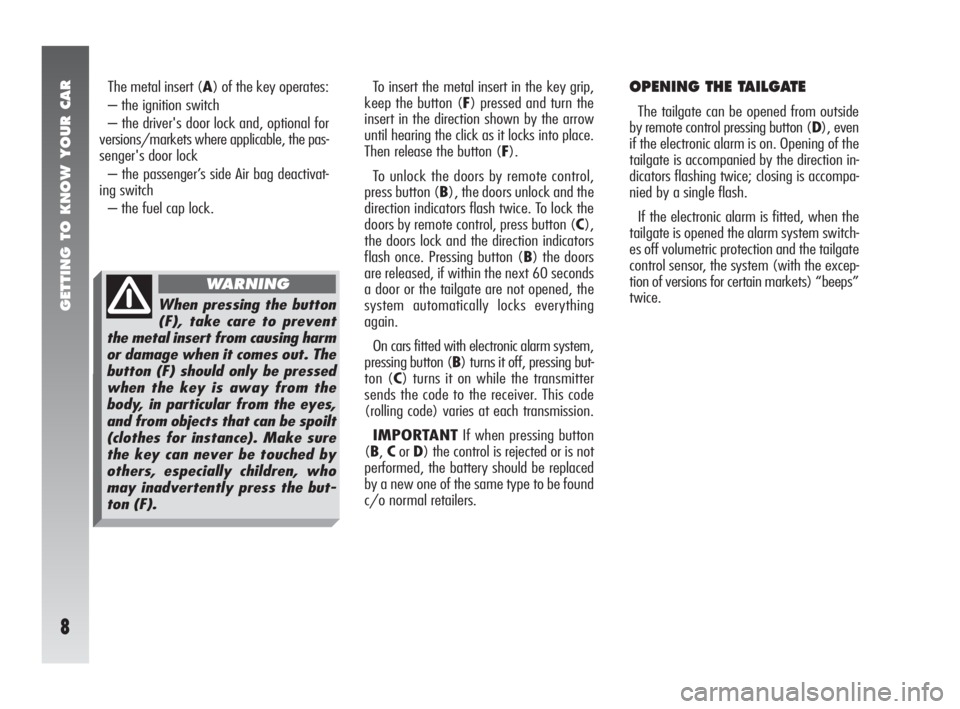
GETTING TO KNOW YOUR CAR
8
To insert the metal insert in the key grip,
keep the button (F) pressed and turn the
insert in the direction shown by the arrow
until hearing the click as it locks into place.
Then release the button (F).
To unlock the doors by remote control,
press button (B), the doors unlock and the
direction indicators flash twice. To lock the
doors by remote control, press button (C),
the doors lock and the direction indicators
flash once. Pressing button (B) the doors
are released, if within the next 60 seconds
a door or the tailgate are not opened, the
system automatically locks everything
again.
On cars fitted with electronic alarm system,
pressing button (B) turns it off, pressing but-
ton (C) turns it on while the transmitter
sends the code to the receiver. This code
(rolling code) varies at each transmission.
IMPORTANTIf when pressing button
(B,CorD) the control is rejected or is not
performed, the battery should be replaced
by a new one of the same type to be found
c/o normal retailers.OPENING THE TAILGATE
The tailgate can be opened from outside
by remote control pressing button (D), even
if the electronic alarm is on. Opening of the
tailgate is accompanied by the direction in-
dicators flashing twice; closing is accompa-
nied by a single flash.
If the electronic alarm is fitted, when the
tailgate is opened the alarm system switch-
es off volumetric protection and the tailgate
control sensor, the system (with the excep-
tion of versions for certain markets) “beeps”
twice. The metal insert (A) of the key operates:
– the ignition switch
– the driver's door lock and, optional for
versions/markets where applicable, the pas-
senger's door lock
– the passenger’s side Air bag deactivat-
ing switch
– the fuel cap lock.
When pressing the button
(F), take care to prevent
the metal insert from causing harm
or damage when it comes out. The
button (F) should only be pressed
when the key is away from the
body, in particular from the eyes,
and from objects that can be spoilt
(clothes for instance). Make sure
the key can never be touched by
others, especially children, who
may inadvertently press the but-
ton (F).
WARNING
Page 13 of 291
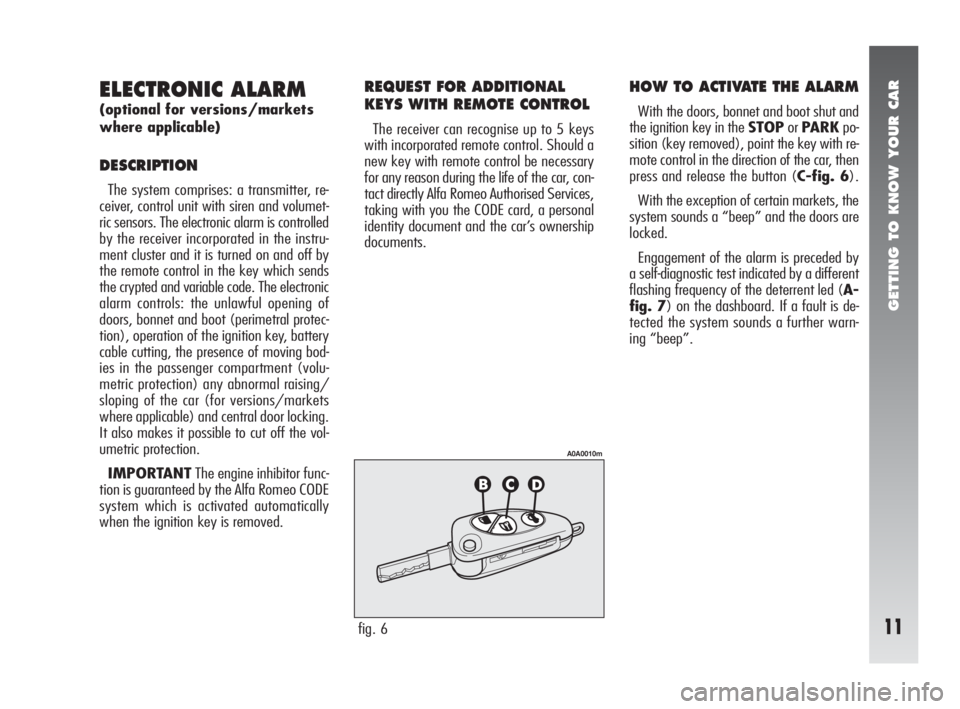
GETTING TO KNOW YOUR CAR
11
ELECTRONIC ALARM
(optional for versions/markets
where applicable)
DESCRIPTION
The system comprises: a transmitter, re-
ceiver, control unit with siren and volumet-
ric sensors. The electronic alarm is controlled
by the receiver incorporated in the instru-
ment cluster and it is turned on and off by
the remote control in the key which sends
the crypted and variable code. The electronic
alarm controls: the unlawful opening of
doors, bonnet and boot (perimetral protec-
tion), operation of the ignition key, battery
cable cutting, the presence of moving bod-
ies in the passenger compartment (volu-
metric protection) any abnormal raising/
sloping of the car (for versions/markets
where applicable) and central door locking.
It also makes it possible to cut off the vol-
umetric protection.
IMPORTANTThe engine inhibitor func-
tion is guaranteed by the Alfa Romeo CODE
system which is activated automatically
when the ignition key is removed.
REQUEST FOR ADDITIONAL
KEYS WITH REMOTE CONTROL
The receiver can recognise up to 5 keys
with incorporated remote control. Should a
new key with remote control be necessary
for any reason during the life of the car, con-
tact directly Alfa Romeo Authorised Services,
taking with you the CODE card, a personal
identity document and the car’s ownership
documents.
HOW TO ACTIVATE THE ALARM
With the doors, bonnet and boot shut and
the ignition key in the STOPorPARKpo-
sition (key removed), point the key with re-
mote control in the direction of the car, then
press and release the button (C-fig. 6).
With the exception of certain markets, the
system sounds a “beep” and the doors are
locked.
Engagement of the alarm is preceded by
a self-diagnostic test indicated by a different
flashing frequency of the deterrent led (A-
fig. 7) on the dashboard. If a fault is de-
tected the system sounds a further warn-
ing “beep”.
fig. 6
A0A0010m
Page 15 of 291

GETTING TO KNOW YOUR CAR
13
– if the led continues flashing, but at dif-
ferent intervals than normal, this means that
different attempts to break in have occurred.
Through the number of flashes it is possi-
ble to identify the type of attempt:
1 flash:one or more doors
2 flashes:tailgate
3 flashes:bonnet
4 flashes:ultrasounds
5 flashes:abnormal vehicle lift-
ing/sloping (for ver-
sions/markets where ap-
plicable)
6 flashes:tampering with car starting
cables
7 flashes:tampering with battery ca-
bles or cutting emergency
key cables
8 flashes:connection line to sensors
and siren
9 flashes:at least three causes of
alarm.WHEN THE ALARM
IS TRIGGERED
When the system is on, the alarm comes
into action in the following cases:
– opening of one of the doors, bonnet or
tailgate;
– disconnection of the battery or section-
ing of electric cables;
– intrusion in the passenger compartment,
for example breakage of windows (volu-
metric protection);
– attempt to start the engine (key in
MARposition);
– abnormal car lifting/sloping (for ver-
sions/markets where applicable).
Depending on the markets, the cutting in
of the alarm causes operation of the siren
and hazard warning lights (for about 26 sec-
onds). The ways of operating and the num-
ber of cycles may vary depending on the
markets.
A maximum number of cycles is however
envisaged.
Once the alarm cycle has ended, the sys-
tem resumes its normal control function.
VOLUMETRIC PROTECTION
To make sure that the protection system
works correctly the side windows and sun-
roof (if fitted) must be properly shut.
The function can be cut off (if, for exam-
ple, leaving animals in the car) carrying out
the following operations in rapid succession:
starting from the condition with the igni-
tion key at MAR, move the key to STOP,
then immediately back to MARand then
toSTOPagain, then remove the ignition
key.
The deterrent led (A-fig. 7) on the dash-
board lights up for about 2 seconds to con-
firm that the function has been cut off.
To restore volumetric protection, move and
keep the ignition key at MARfor over 30
seconds.
If, with the volumetric protection function
deactivated, an electric control controlled by
the ignition key at MARis required (e.g.
power windows) turn the key to MAR, op-
erate the control and move the key to
STOPin a maximum time of 30 seconds.
This way volumetric protection is not re-
stored.
Page 38 of 291
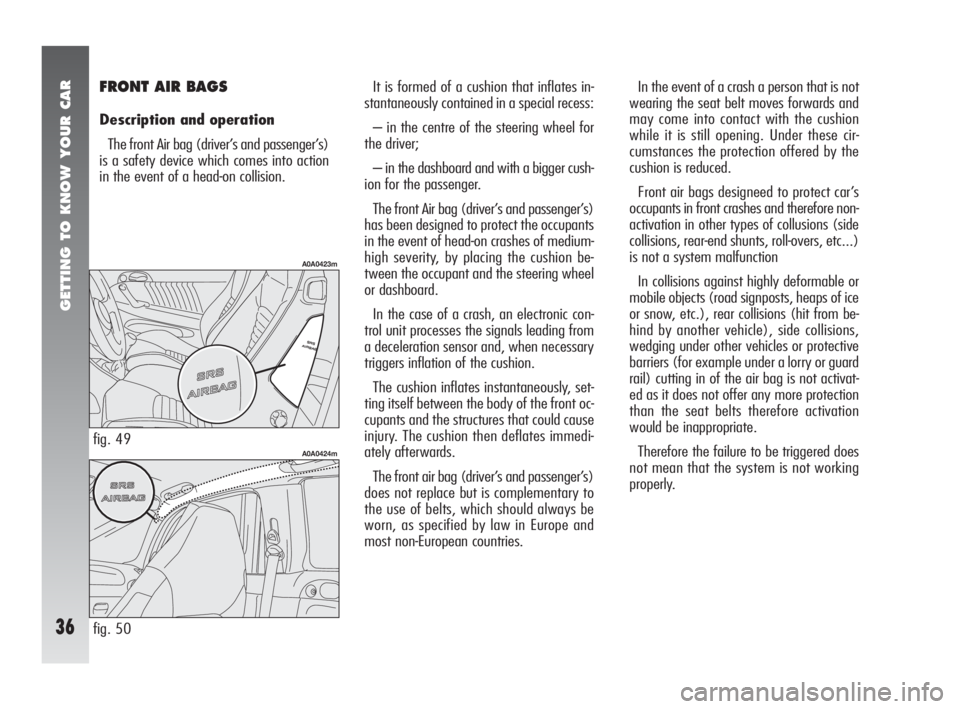
GETTING TO KNOW YOUR CAR
36
It is formed of a cushion that inflates in-
stantaneously contained in a special recess:
– in the centre of the steering wheel for
the driver;
– in the dashboard and with a bigger cush-
ion for the passenger.
The front Air bag (driver’s and passenger’s)
has been designed to protect the occupants
in the event of head-on crashes of medium-
high severity, by placing the cushion be-
tween the occupant and the steering wheel
or dashboard.
In the case of a crash, an electronic con-
trol unit processes the signals leading from
a deceleration sensor and, when necessary
triggers inflation of the cushion.
The cushion inflates instantaneously, set-
ting itself between the body of the front oc-
cupants and the structures that could cause
injury. The cushion then deflates immedi-
ately afterwards.
The front air bag (driver’s and passenger’s)
does not replace but is complementary to
the use of belts, which should always be
worn, as specified by law in Europe and
most non-European countries.In the event of a crash a person that is not
wearing the seat belt moves forwards and
may come into contact with the cushion
while it is still opening. Under these cir-
cumstances the protection offered by the
cushion is reduced.
Front air bags designeed to protect car’s
occupants in front crashes and therefore non-
activation in other types of collusions (side
collisions, rear-end shunts, roll-overs, etc...)
is not a system malfunction
In collisions against highly deformable or
mobile objects (road signposts, heaps of ice
or snow, etc.), rear collisions (hit from be-
hind by another vehicle), side collisions,
wedging under other vehicles or protective
barriers (for example under a lorry or guard
rail) cutting in of the air bag is not activat-
ed as it does not offer any more protection
than the seat belts therefore activation
would be inappropriate.
Therefore the failure to be triggered does
not mean that the system is not working
properly.FRONT AIR BAGS
Description and operation
The front Air bag (driver’s and passenger’s)
is a safety device which comes into action
in the event of a head-on collision.
fig. 49
A0A0423m
fig. 50
A0A0424m
Page 40 of 291
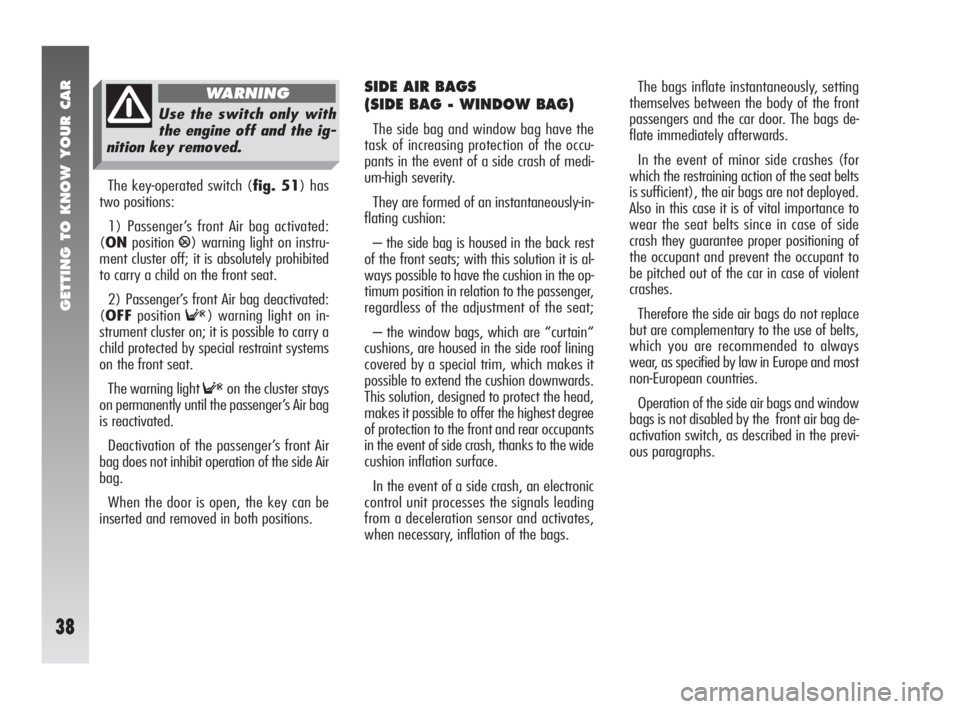
GETTING TO KNOW YOUR CAR
38
The key-operated switch (fig. 51) has
two positions:
1) Passenger’s front Air bag activated:
(ONposition
P) warning light on instru-
ment cluster off; it is absolutely prohibited
to carry a child on the front seat.
2) Passenger’s front Air bag deactivated:
(OFFposition
F) warning light on in-
strument cluster on; it is possible to carry a
child protected by special restraint systems
on the front seat.
The warning light
Fon the cluster stays
on permanently until the passenger’s Air bag
is reactivated.
Deactivation of the passenger’s front Air
bag does not inhibit operation of the side Air
bag.
When the door is open, the key can be
inserted and removed in both positions.
SIDE AIR BAGS
(SIDE BAG - WINDOW BAG)
The side bag and window bag have the
task of increasing protection of the occu-
pants in the event of a side crash of medi-
um-high severity.
They are formed of an instantaneously-in-
flating cushion:
– the side bag is housed in the back rest
of the front seats; with this solution it is al-
ways possible to have the cushion in the op-
timum position in relation to the passenger,
regardless of the adjustment of the seat;
– the window bags, which are “curtain“
cushions, are housed in the side roof lining
covered by a special trim, which makes it
possible to extend the cushion downwards.
This solution, designed to protect the head,
makes it possible to offer the highest degree
of protection to the front and rear occupants
in the event of side crash, thanks to the wide
cushion inflation surface.
In the event of a side crash, an electronic
control unit processes the signals leading
from a deceleration sensor and activates,
when necessary, inflation of the bags.The bags inflate instantaneously, setting
themselves between the body of the front
passengers and the car door. The bags de-
flate immediately afterwards.
In the event of minor side crashes (for
which the restraining action of the seat belts
is sufficient), the air bags are not deployed.
Also in this case it is of vital importance to
wear the seat belts since in case of side
crash they guarantee proper positioning of
the occupant and prevent the occupant to
be pitched out of the car in case of violent
crashes.
Therefore the side air bags do not replace
but are complementary to the use of belts,
which you are recommended to always
wear, as specified by law in Europe and most
non-European countries.
Operation of the side air bags and window
bags is not disabled by the front air bag de-
activation switch, as described in the previ-
ous paragraphs.
Use the switch only with
the engine off and the ig-
nition key removed.
WARNING
Page 47 of 291
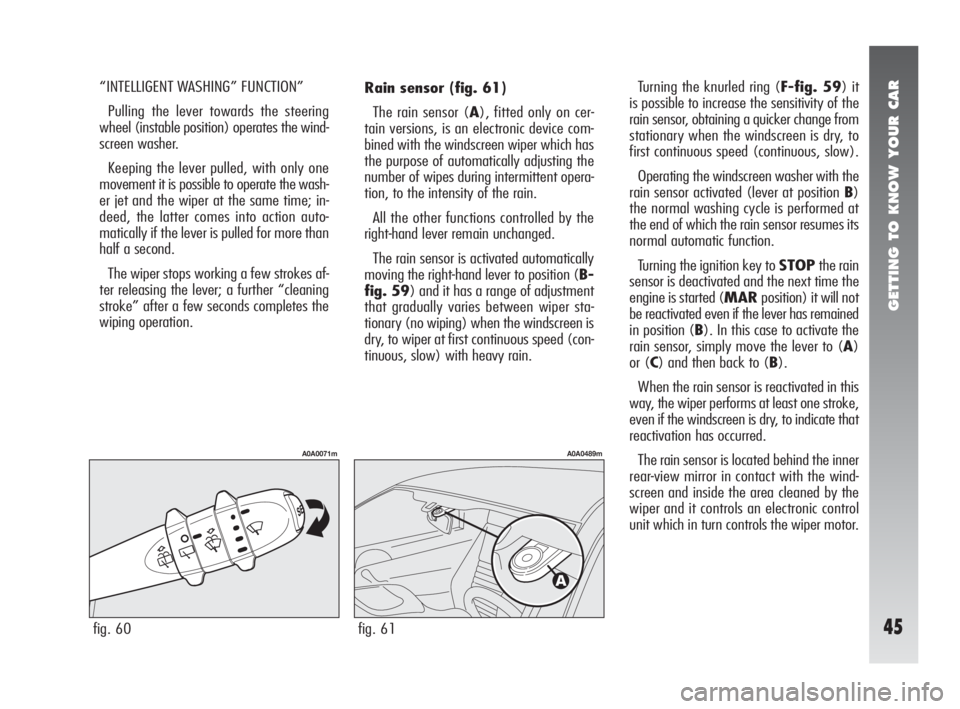
GETTING TO KNOW YOUR CAR
45
Rain sensor (fig. 61)
The rain sensor (A), fitted only on cer-
tain versions, is an electronic device com-
bined with the windscreen wiper which has
the purpose of automatically adjusting the
number of wipes during intermittent opera-
tion, to the intensity of the rain.
All the other functions controlled by the
right-hand lever remain unchanged.
The rain sensor is activated automatically
moving the right-hand lever to position (B-
fig. 59) and it has a range of adjustment
that gradually varies between wiper sta-
tionary (no wiping) when the windscreen is
dry, to wiper at first continuous speed (con-
tinuous, slow) with heavy rain.Turning the knurled ring (F-fig. 59) it
is possible to increase the sensitivity of the
rain sensor, obtaining a quicker change from
stationary when the windscreen is dry, to
first continuous speed (continuous, slow).
Operating the windscreen washer with the
rain sensor activated (lever at position B)
the normal washing cycle is performed at
the end of which the rain sensor resumes its
normal automatic function.
Turning the ignition key to STOPthe rain
sensor is deactivated and the next time the
engine is started (MARposition) it will not
be reactivated even if the lever has remained
in position (B). In this case to activate the
rain sensor, simply move the lever to (A)
or (C) and then back to (B).
When the rain sensor is reactivated in this
way, the wiper performs at least one stroke,
even if the windscreen is dry, to indicate that
reactivation has occurred.
The rain sensor is located behind the inner
rear-view mirror in contact with the wind-
screen and inside the area cleaned by the
wiper and it controls an electronic control
unit which in turn controls the wiper motor. “INTELLIGENT WASHING” FUNCTION”
Pulling the lever towards the steering
wheel (instable position) operates the wind-
screen washer.
Keeping the lever pulled, with only one
movement it is possible to operate the wash-
er jet and the wiper at the same time; in-
deed, the latter comes into action auto-
matically if the lever is pulled for more than
half a second.
The wiper stops working a few strokes af-
ter releasing the lever; a further “cleaning
stroke” after a few seconds completes the
wiping operation.
fig. 60
A0A0071m
fig. 61
A0A0489m
Page 48 of 291
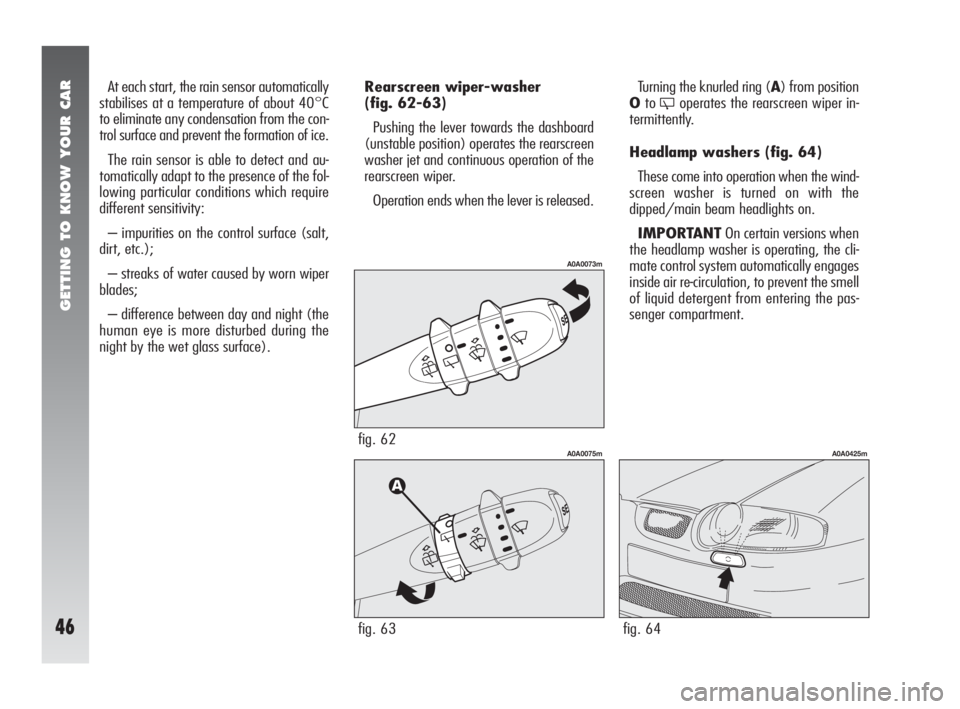
GETTING TO KNOW YOUR CAR
46
At each start, the rain sensor automatically
stabilises at a temperature of about 40°C
to eliminate any condensation from the con-
trol surface and prevent the formation of ice.
The rain sensor is able to detect and au-
tomatically adapt to the presence of the fol-
lowing particular conditions which require
different sensitivity:
– impurities on the control surface (salt,
dirt, etc.);
– streaks of water caused by worn wiper
blades;
– difference between day and night (the
human eye is more disturbed during the
night by the wet glass surface).Rearscreen wiper-washer
(fig. 62-63)
Pushing the lever towards the dashboard
(unstable position) operates the rearscreen
washer jet and continuous operation of the
rearscreen wiper.
Operation ends when the lever is released.
fig. 62
A0A0073m
fig. 63
A0A0075m
Turning the knurled ring (A) from position
Oto
'operates the rearscreen wiper in-
termittently.
Headlamp washers (fig. 64)
These come into operation when the wind-
screen washer is turned on with the
dipped/main beam headlights on.
IMPORTANTOn certain versions when
the headlamp washer is operating, the cli-
mate control system automatically engages
inside air re-circulation, to prevent the smell
of liquid detergent from entering the pas-
senger compartment.
fig. 64
A0A0425m
Page 52 of 291
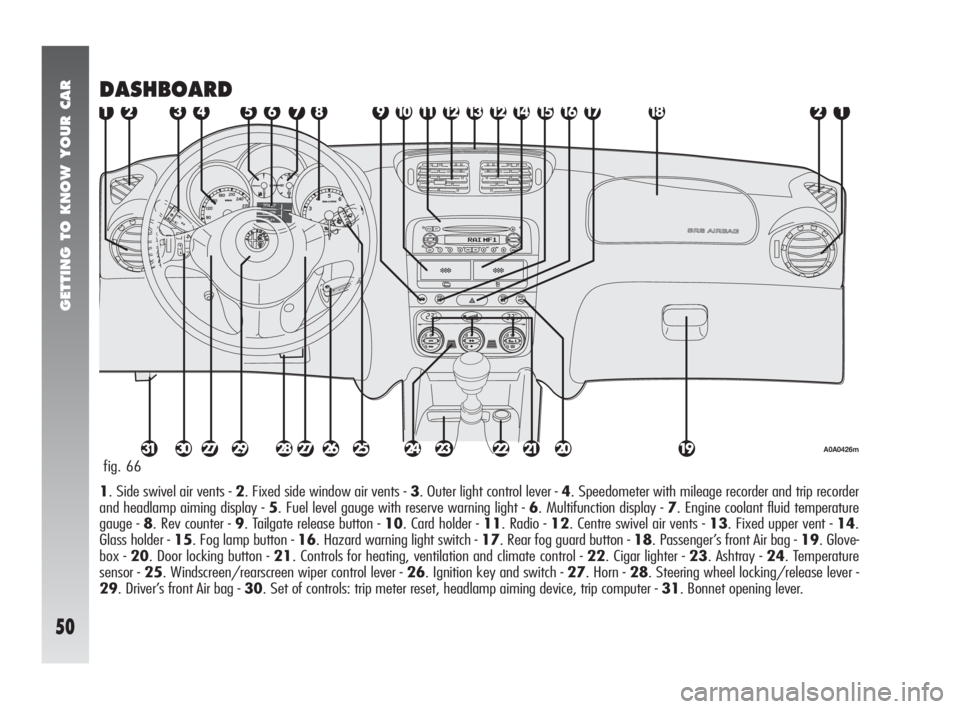
GETTING TO KNOW YOUR CAR
50
DASHBOARD
1. Side swivel air vents - 2. Fixed side window air vents - 3. Outer light control lever - 4. Speedometer with mileage recorder and trip recorder
and headlamp aiming display - 5. Fuel level gauge with reserve warning light - 6. Multifunction display - 7. Engine coolant fluid temperature
gauge - 8. Rev counter - 9. Tailgate release button - 10. Card holder - 11. Radio - 12. Centre swivel air vents - 13. Fixed upper vent - 14.
Glass holder - 15. Fog lamp button - 16. Hazard warning light switch - 17. Rear fog guard button - 18. Passenger’s front Air bag - 19. Glove-
box - 20. Door locking button - 21. Controls for heating, ventilation and climate control - 22. Cigar lighter - 23. Ashtray - 24. Temperature
sensor - 25. Windscreen/rearscreen wiper control lever - 26. Ignition key and switch - 27. Horn - 28. Steering wheel locking/release lever -
29. Driver’s front Air bag - 30. Set of controls: trip meter reset, headlamp aiming device, trip computer - 31. Bonnet opening lever. fig. 66
A0A0426m
Page 82 of 291
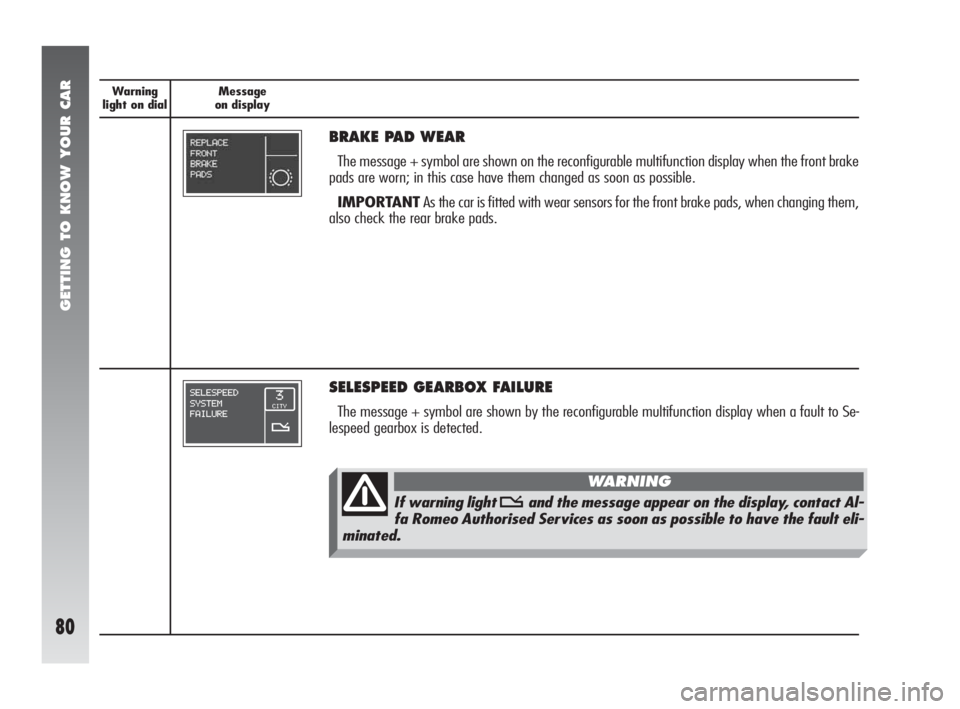
GETTING TO KNOW YOUR CAR
80
Warning
light on dialMessage
on display
BRAKE PAD WEAR
The message + symbol are shown on the reconfigurable multifunction display when the front brake
pads are worn; in this case have them changed as soon as possible.
IMPORTANTAs the car is fitted with wear sensors for the front brake pads, when changing them,
also check the rear brake pads.
SELESPEED GEARBOX FAILURE
The message + symbol are shown by the reconfigurable multifunction display when a fault to Se-
lespeed gearbox is detected.
If warning light tand the message appear on the display, contact Al-
fa Romeo Authorised Services as soon as possible to have the fault eli-
minated.
WARNING
Page 93 of 291
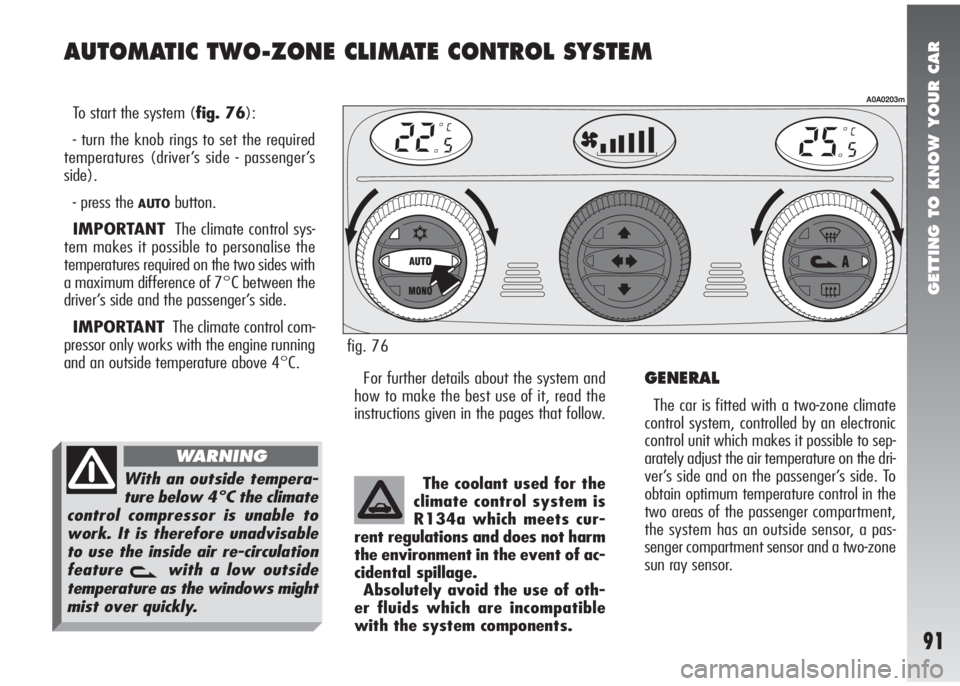
GETTING TO KNOW YOUR CAR
91
AUTOMATIC TWO-ZONE CLIMATE CONTROL SYSTEM
To start the system (fig. 76):
- turn the knob rings to set the required
temperatures (driver’s side - passenger’s
side).
- press the
AUTObutton.
IMPORTANTThe climate control sys-
tem makes it possible to personalise the
temperatures required on the two sides with
a maximum difference of 7°C between the
driver’s side and the passenger’s side.
IMPORTANTThe climate control com-
pressor only works with the engine running
and an outside temperature above 4°C.
For further details about the system and
how to make the best use of it, read the
instructions given in the pages that follow.
A0A0203m
fig. 76
The coolant used for the
climate control system is
R134a which meets cur-
rent regulations and does not harm
the environment in the event of ac-
cidental spillage.
Absolutely avoid the use of oth-
er fluids which are incompatible
with the system components.
GENERAL
The car is fitted with a two-zone climate
control system, controlled by an electronic
control unit which makes it possible to sep-
arately adjust the air temperature on the dri-
ver’s side and on the passenger’s side. To
obtain optimum temperature control in the
two areas of the passenger compartment,
the system has an outside sensor, a pas-
senger compartment sensor and a two-zone
sun ray sensor.
With an outside tempera-
ture below 4°C the climate
control compressor is unable to
work. It is therefore unadvisable
to use the inside air re-circulation
feature
vwith a low outside
temperature as the windows might
mist over quickly.
WARNING